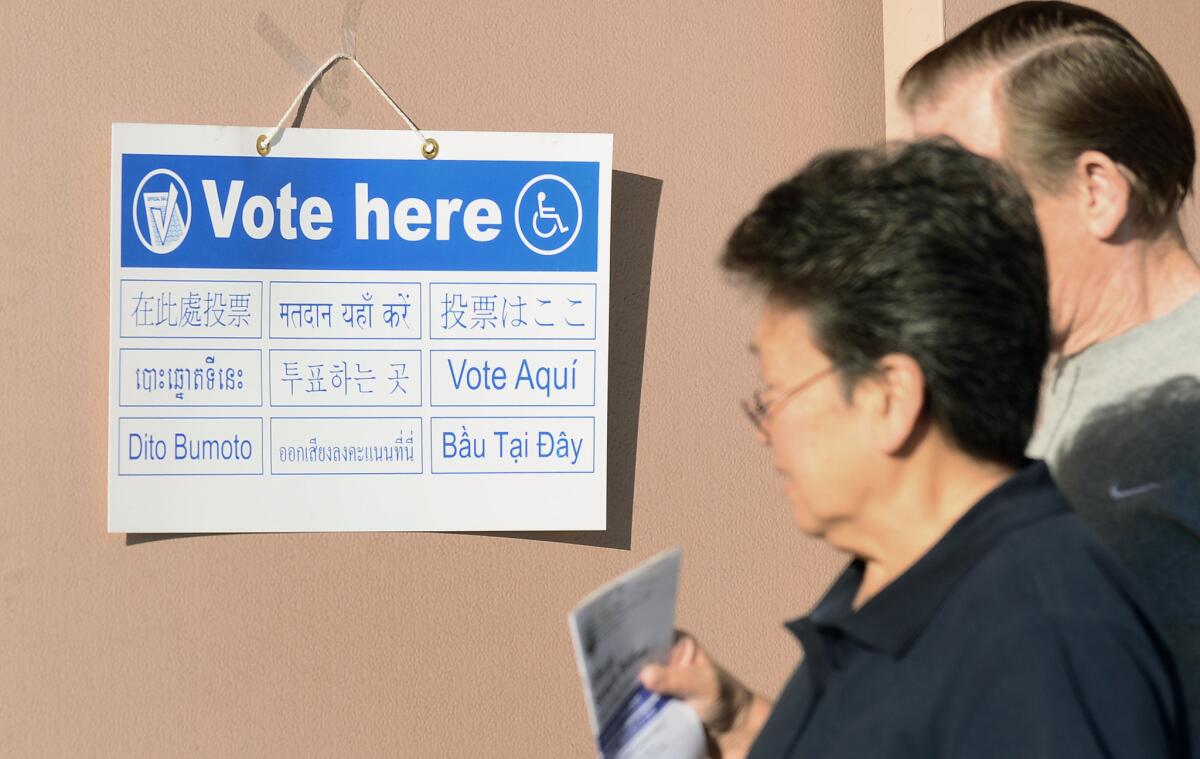Asian Americans turn Democratic

- Share via
As the dust settles on the presidential election, there seems to be a new theory daily as to why Mitt Romney lost and what it signals for the future of the Republican Party. Common to nearly all the speculation are the partisan implications of demographic change. The United States is shifting gradually toward a majority-minority electorate, with ever-growing numbers of Latino and Asian American voters. Notably, these groups are increasingly voting as Democrats. According to exit polls from Nov. 6, 73% of Asian Americans and 71% of Latinos voted for President Obama.
The high levels of Latino support for Obama were in line with expectations. The myriad preelection polls from Latino Decisions, the Pew Hispanic Center and many others pointed toward an overwhelming Latino majority in support of the president.
But the fact that nearly three out of every four Asian Americans voted for Obama caught most pundits by surprise. Moreover, Asian Americans, who voted in record numbers in 2008, appear to have mobilized an even higher turnout in 2012. Asian Americans are no longer a swing vote or a crouching tiger in the electorate; their political stripes are now distinctly Democratic blue.
Many people have begun to ask: Why are Asian Americans so Democratic, and how did they get that way? These questions take on greater intrigue when we look at exit poll data over the last two decades. Asian Americans have demonstrated the biggest shift in their presidential voting preferences of any demographic group, whether by race, gender or age. They doubled their vote share for the Democratic candidate, from 31% in 1992 to 62% in 2008, and voted even more Democratic in 2012 (73%).
As political scientists who have analyzed Asian American politics for more than a decade and collaborated on two of the most exhaustive and sustained surveys of Asian American politics in 2008 and 2012, we have some explanations for this dramatic shift.
First, it is no accident that the move toward the Democratic Party started during Bill Clinton’s presidency. Although detailed polling data on Asian Americans in the 1990s are lacking, this is a period when the Democratic Party developed a new pro-business image, economic growth was strong, Asian Americans naturalized in unprecedented numbers and Clinton made public efforts to woo them, including nominating the first Asian American to the Cabinet. Still, even by 2000, Asian Americans were roughly evenly split in their choice between Al Gore and George W. Bush.
Since 2000, the Republican Party has moved more sharply to the right than the Democratic Party has to the left, especially on issues that resonate with Asian Americans. For example, Republicans in Congress escalated their heated rhetoric on immigration and, despite the Bush administration’s efforts, consistently scuttled efforts toward comprehensive immigration reform. Our 2008 National Asian American Survey also found very strong support among all Asian American groups for universal healthcare and for bringing a quick end to the Iraq war, two issues on which the Republican Party did itself no favors with these voters.
This mix of “push” and “pull” factors continued during the first Obama administration. On the “push” side of the ledger, the Republican Party has not been helped by its close liaison with the tea party movement, which received low favorability ratings in our 2012 survey, nor by presidential candidates and party activists emphasizing Christian values. Thus a Pew report on Asian American religion showed the highest Democratic Party support among Hindus and the religiously unaffiliated who, together, account for more than 35% of the Asian American population.
On the “pull” side is the significant rise in the number of Asian Americans Obama has appointed, from Cabinet positions to the World Bank, and policy achievements that matter to Asian Americans like healthcare (the Affordable Care Act), education (college loans and the Race to the Top initiative) and foreign policy (ending the Iraq war). On all these matters, and even on job creation, our 2012 survey showed Asian Americans giving a sizable edge to Obama over Romney. It is no surprise, then, that Obama did even better among Asian Americans in 2012 than in 2008.
Still, there is hope for the Republican Party. Our surveys and others consistently show a high proportion of Asian Americans who are unaffiliated with either party (just over 50% in our 2012 survey). This is understandable given that the foreign-born account for two-thirds of Asian American voters, and most are still trying to become familiar with the U.S. political system. If Republicans step up their efforts to contact Asian American voters, and if they are able to project a more inclusive image of the party on immigration and religious diversity, they can hope to reverse their steep descent among Asian American voters.
Taeku Lee is a professor of political science and law at UC Berkeley. Karthick Ramakrishnan is an associate professor of political science at UC Riverside. Ramakrishnan is director and co-principal investigator and Lee is co-principal investigator of the 2012 National Asian American Survey.
More to Read
A cure for the common opinion
Get thought-provoking perspectives with our weekly newsletter.
You may occasionally receive promotional content from the Los Angeles Times.






